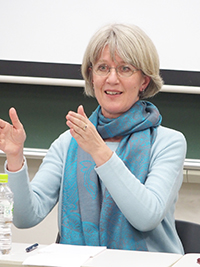IGS seminar: Are Market Conditions Better in Achieving Gender Equality than Politics? Abe’s ‘Womenomics’ and Beyond
On February 9, 2018, a seminar, entitled ‘Are Market Conditions Better in Achieving Gender Equality than Politics? Abe’s ‘Womenomics’ and Beyond’, was held by the Institute for Gender Studies (IGS). This event featured a lecture by Dr Annette Schad-Seifert (Specially Appointed Professor, IGS/Professor, Heinrich Heine University Düsseldorf). Against the backdrop that the program of the Abe government to promote women is failing to achieve its numerical targets, this event foregrounded the shortcomings of the policy as a whole.
In September 2013, in a speech before the United Nations General Assembly, Prime Minister Abe pronounced the intention of conducting structural reforms to create ‘a society in which all women shine’. The plan for this reform, often called Womenomics, forms part of his economic strategy, called Abenomics. Prior policies and earlier speeches have suggested that Abe will never become a feminist, but the introduction of this policy was made inevitable by global trends of initiatives to promote women within plans targeting economic growth, as advocated by international finance and business organisations. More precisely, the Abe government’s policy relied on reports produced by Goldman Sachs on investment strategies in the Japanese market.
The contents of these reports bear a similarity to social analysis, but their aim is how the proposition to enter into business partnerships in Japan appears to investors. It notes out that Japan’s current state, ranked at 114th place in the Gender Gap Index, is a factor that may cause investors to lose interest. Such analyses stem entirely from the perspective of American financial business and do not adequately take into account Japanese socio-cultural conditions. This, however, is the underlying concept and foundation for the current policy on women’s advancement.
There has been a generally increasing trend, beginning in the 1980s, of progress in the utilisation of women in the Japanese workforce. The number of women who leave their workplaces at marriage or childbirth is declining. However, even now, the employment rate for married women remains remarkably low by the standards of Japan’s peer countries, while the employment rate of unmarried women is now as high as that of men. Economic stagnation has lowered the employment rate for both genders, but the rate for women is levelling off, while the rate for men is declining. A strikingly high percentage of women are non-regular employees, but an increase in this category can be seen for both genders. This trend reflects changes in industrial structure. In the growing service sector, which includes medicine, the caring professions, hotel work, restaurants, housework, entertainment, education and finance, women account for more than 50% of all workers. The shift of the major part of production from manufacturing to service has increased the need for women in the workforce.
Measures of women’s promotion vary according to what household model is intended to create. Schad-Seifert listed three models for variation in income and care provider, namely, (1) the male-breadwinner model, (2) the dual-earner work–life-balance model and (3) the market-oriented model. (1) The male-breadwinner model was long standard for Japanese society. Although, the number of households embodying this model has been declining in recent years, it is persistent as a social norm, and there has been no intention to carry out radical change here. Recent measures have had as their preferred outcomes (2) the dual earner work-life-balance model, which has been successful in the Scandinavian countries. Although the Basic Act for Gender-Equal Society has been enacted and in force since 1999, and public childcare service was intended to be improved, there has been no sufficient implementation of the system, and therefore, no favourable results have been delivered. To manage this delayed progress, it has been suggested to move to (3) a market-oriented model that utilises the private-service sector for house work, childcare and other cares. In the US, the availability of inexpensive outsourced services makes this model possible, and Goldman Sachs’s report urges greater privatisation of childcare services. Abe considered this to be a magic solution and promoted the acceptance of foreign domestic workers under the title of the National Strategic Special Zone.
Abe’s Womenomics embodies a strategy for economic growth across the board, but sustainability is excluded from this vision. The introduction of a private-sector model for care services may lighten the existing burden on the national budget, although it would not tend to reduce the national debt. The traditional gender division of labour would remain in such a system. Schad-Seifert brought it to the attention of the audience that this strategy lacks a vision for what type of society Japan should create to ensure a better future.
As noted above, Schad-Seifert’s lecture sharply critiqued the Japanese policy of the promotion of women, which only manages to use women to fill workforce shortages, rather than intending the realisation of a sustainable, gender-equal society. In the following discussion, a comparison made by Dr Schad-Seifert between the housework and childcare systems of Japan and Germany and between the former West Germany and the former East Germany made the similarities and differences among quite clear. Childcare services in the former communist region, for example, included a nursery at every workplace, which appears to be a model for the extent of childcare support currently desired in Japan, although this model, under a communist regime, also had set as its goal a mobilisation of the workforce without regard for gender. This seminar vividly brought before its audience the depth of the question, ‘What type of society do we want to create’?



